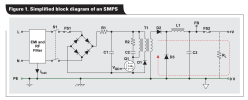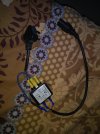FWIW, this is not necessarily indicative of a bad ground.
Most AVRs use a non grounded chassis to avoid ground loop.
Easy to check as well, the mains inlet on the AVR will most likely be two pin.
Indeed. However these AVRs are two pin for a reason - To prevent the noise these units generate back into the mains. They have an internal SMPS to power the standby circuits. See a representative circuit below. Once you have an SMPS, there will be leakage from two or three places. One is the EMI filter. All SMPS require it to reduce the high frequency noise created by the switching mosfet or the PWM controller IC. The 240 mains voltage gets rectified and with the bulk capacitor C1 you now have a dangerous 339 volts DC (multiply RMS by 1.414). This voltage is then switched by Q1 to generate the desire voltage in T1. Here is where the second leakage happens. There always will be capacitance between the primary and secondary windings of the transformer T1, since they are wound on the same core. There is a third place where this leakage occurs. Since we have dangerous voltage coming inside, if any malfunction happens and the current from the live enters the circuit we can get electrocuted. So to prevent that we have two safety capacitors connected. One from the live to the ground and another from the neutral to the ground. The capacitors have to be of the same value. This capacitors will pass the live current in case of high leakage and they are designed to fail short. This will blow the fuse and hence electrocution will be prevented. But the side effect of having these two capacitors is again leakage when the capacitance value changes with age.
So, just because we have deployed a SMPS, we now have a situation where current from the mains has leaked to the 0 volts line in the below circuit. This 0v line will be the equipment chasis. Now If we connect the chasis to the earth ground, the current will find a way to flow back causing currents through unintended portions of the AVR circuit. This will cause noise. However most people (including me) will connect the AVR to a television set using a HDMI cable. The TV will have 3 wires and through the HDMI outer metal connector we have just provided the leakage current from the AVR to flow through the HDMI cable to the TV's earch connection. Similar thing will happen if we connect a pre-amp to the AVR and the pre-amp has a 3-pin plug. The moment you connect the RCA cable from the pre-amp to the AVR, you provide a path for the leakage current to flow through the RCA. These AVRs have a gimmick. My Yamaha has something called Pure Direct. It does improve the sound by switching off the power supply to the HDMi board, but the SMPS still remains on. So the 'Pure Direct' mode doesn't eliminate the entire noise.
Medical equipment have stringent controls and norms for this leakage current, but I have no idea how they are designed. Most of these AVRs have a good quality transformer inside and that too can by itself provide all the power needs. So why do they deploy a small SMPS for the standby circuit. This is to do with stringent Euro Norms which specify that equipment should have green power supplies which consume power in few miliwatts in standby mode. Transformer based power supplies are notoriously ineffecient. Even with no load, the large transformer of an AVR will draw power in watts. In contrast a SMPS is usually more than 90% efficient. With no-load, a SMPS hardly draws power.
I like it when you to divorce the equipment from the power supply (e.g. laptops). But for good sound, I avoid using AVR or any equipment that have these noisy SMPS for anything that values sound quality. Google, Amazon, even MI have done it right by having a separate 5v power supply that goes into their units (Chromecast Audio, firestick, mi box). But the purpose for good sound is defeated because they all use a 5v SMPS and SMPS will always leak some current. So ultimately they too are no better than units like apple tv which has 339 voltage right inside the unit.

image taken from
So what do you do when you want pristine sound.
0. Use an AMP with 3 pin plug
1. Turn off all your cell phone charges
2. Turn off the TV
3. Don't have your wi-fi router near your amp
4. Turn off your apple tv, chromecast, firestick mi box, etc (turn of the main power supply to them).
5. Since other in your household will be using laptop power supply, cell phone chargers, etc connected to mains, you will have EMI leaking into the mains. So use an EMI filter. Most old audio amplifiers, tube amplifiers, etc manufactured before the millenium did not have any SMPS inside. So they will not have any EMI filter for the mains. So this is what I do. These EMI filters cost around 300 bucks. I use this with my stereo amp. This is exactly what so many (fake) power conditioners do. I know one which costs more than a decent amp but actually has passive LCR component inside..
6. Use an isolation transfer (maybe this should be the first thing).




